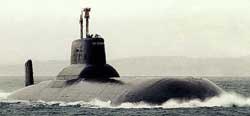 On
16 October 1996 Commander in Chief of the Russian Navy
ADM Feliks Gromov announced that work would start on a
new-generation strategic nuclear-powered submarine, which
he said would be "two or three times more powerful"
than any submarine currently in the fleet. On
16 October 1996 Commander in Chief of the Russian Navy
ADM Feliks Gromov announced that work would start on a
new-generation strategic nuclear-powered submarine, which
he said would be "two or three times more powerful"
than any submarine currently in the fleet.
The keel of the fourth-generation strategic
missile submarine Yuri Dolgoruky was laid down at the
Sevmash State Nuclear Ship-Building Centre at Severodvinsk
on 2 November 1996. The keel-laying was postponed for
a week after poor weather made it impossible for high
ranking officials to attend, including First Deputy
Defense Minister Andrei Kokoshin, Presidential Chief
of Staff Anatoly Chubais, Moscow mayor Yuri Luzkhov,
and Admiral Gromov. Kokoshin described the new Yuri
Dolgoruky as a state-of-the-art submarine with "substantial
improvements" over those currently in service,
and Chubais termed the new submarine "a totally
unique thing, a submarine for the next century."
The city of Moscow is sponsoring the
project, as the lead vessel is named after Prince Dolgoruky,
the traditional founder of the city. The wages of shipyard
workers and the crew of the new boat will [reportedly]
be paid by the city in the event that the federal government
is unable to pay. So-called "Presentation"
weapons were commonplace in the Red Army during the
Great Patriotic War. Presentation weapons were almost
always the result of monetary collections taken up locally
and voluntarily, and offered towards the cost of various
vehicles or other items in the name of some personality
or entity. Thus, the workers of a factory, town, or
even just local citizens could take up a collection
and "buy" a tank or aircraft (etc.) in the
name of their Factory, group, or perhaps a local or
even national figure -- contemporary or historical.
One of the oldest Russian annals, the
Lavrenty Chronicle, was compiled in Nizhny Novgorod
at the request of Prince Dmitry Konstantinovich. It
contains "The Instructions to His Children of Vladimir
Monomakh". Vladimir Monomach ruled in Kiev, the
then capital of the Russian state, between 1113 and
1125. He was the father of Yuri Dolgoruky, the founder
of Moscow. The meeting of Prince Dolgoruky and Prince
Svyatoslav Olgovich on 04 April 1147 in Moscow is the
oldest mentioning of Moscow in chronicles.
This is the first submarine of the new
Borei-class [Boreas], with a length of 170 meters, a
body diameter around 10 metres, and a submerged speed
of over 25 knots (over 45km/h). With about half the
displacement of the Typhoon, the 935 class will nonetheless
carry 20 SLBMs of a new type.
The lead unit of Russia's fourth generation
ballistic missile submarine would have reached initial
operational capability by 2004, if the current plan
of launching it by 2002 remained on track. But the Navy
leadership's plans to launch one new-generation submarine
per year beginning in 2002 appear unrealistic with the
planned financing of national defense. Consequently
no more than 9-12 missile-armed submarines with a total
of 800-1,000 warheads are likely to remain in the naval
strategic nuclear forces by 2010, although the START
I and II treaties allow Russia to have up to 1,750-1,900
warheads in the naval component.
As of early 1999 it appeared that construction
had ceased on the first unit of the Borei-class, pending
a redesign of the ship to accomodate a different missile
from the originally intended SS-N-28, which had failed
its first three test firings and was subsequently said
to have been abandoned. The first remains under construction
with a scheduled launch in 2005. Other sources state
the commissioning year to be 2007-2010, depending on
availability of funds.
The creation of D-19UTH missile complex
designed for the new nuclear strategic submarines of
the Borei-class has been undertaken at GRTs KB named
after V. P. Makeev. The D-19UTH launch complex is to
replace the D-9 launch complex with RSM-52 ballistic
missiles. The new complex will be equipped with a solid-fuel
ballistic missile of greater reliability and longer
range, capable of being fired from the surface and under-water
positions.
As of June 2000 the Russian Navy claims
that it operates 26 strategic nuclear submarines carrying
2,272 nuclear warheads on 440 ballistic missiles. This
force is said to consist of 5 Typhoon class submarines,
7 Delta-IV class submarines, and 13 Delta-III class
submarines [which only adds up to 25, not 26 submarines].
Not all of these submarines are presently seaworthy.
The oldest of these boats, which entered service in
1983, will reach the end of their 20-25 year service
life about the time the first 935 is commissioned. The
Russian Navy reportedly believes that 12 strategic nuclear
submarines with ballistic missiles represent the minimum
necessary force structure. According to media reports
a classified presidential decree of 04 March 2000 established
this force goal for the period through 2010.
|